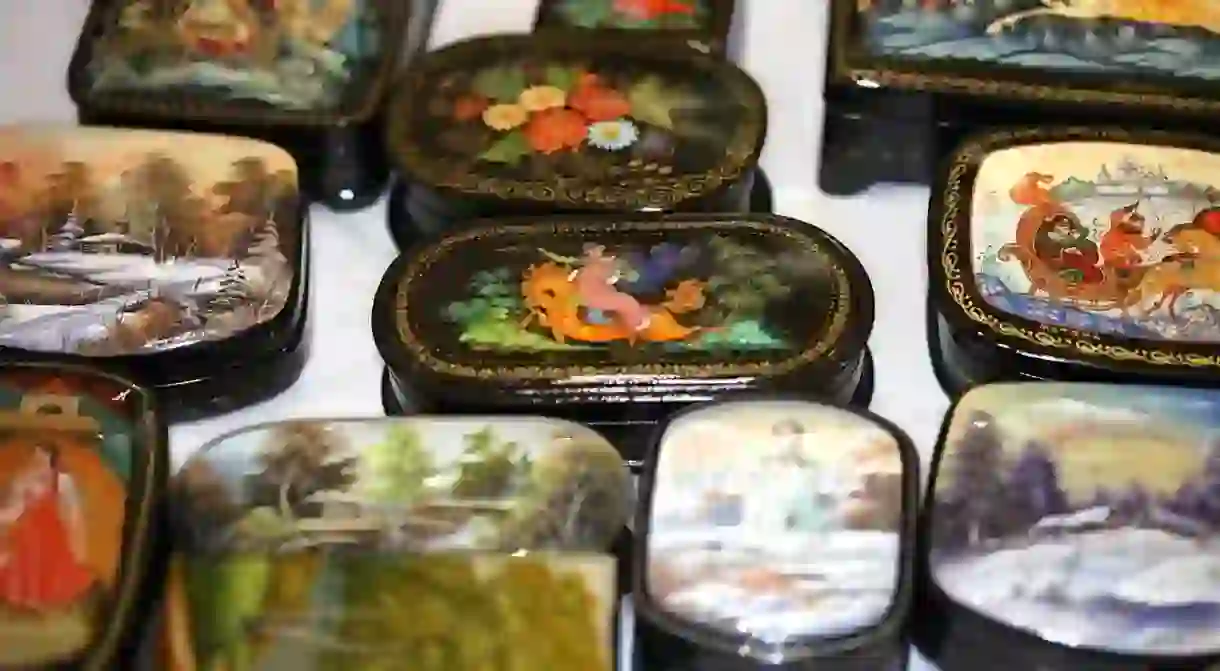A Guide to Russian Lacquer Miniatures

These seemingly simple jewellery boxes are really not what they appear to be at first glance. Behind each one are centuries of trial and error, many months of work and the skills of talented artists. Lacquer miniatures are not just souvenirs; they are collectables and works of art.
Lacquer miniatures in Russia
The history of lacquer miniatures dates back into the past before Russia was even considered a unified country. The tradition of using lacquer for decorative purposes originated in the East before the start of the Common Era and made its way down trade routes towards Europe in the 15th-17th centuries. Russia first became acquainted with lacquer miniatures in the 18th century, during the time of Peter the Great, who encouraged adapting European traditions. Among them was the use of tobacco, which in turn generated a need for tobacco boxes. A merchant named Korobov set up a factory in Fedoskino, a village near Moscow, producing papier-mâché boxes that were decorated with oil paints and covered in lacquer. Fedoskino became the first school of Russian lacquer miniatures with a distinctive style and tradition.

The appearance of new schools
Up until the 20th century, Fedoskino was the only producer of lacquer miniatures. A common subject for this school were portraits or landscape paintings, reflecting the current fashions in art. The appearance of new schools was triggered by the 1917 Revolution in Russia. After the establishment of Communist rule, religion was no longer allowed in the country, and there was no longer a demand for religious icon paintings. In turn, icon masters were now out of a job, yet they did not give up their art completely. Alternatively, they began producing lacquer miniatures that were inspired by icon painting and contained elements of religious art. Thus, three new schools of lacquer miniature appeared named Palekh, Kholuy and Mstyora.

Production of papier-mâché boxes
Although the four schools have certain artistic differences, how the base for their art – the actual box – is made is largely the same. Yet, the process is not easy; it is extremely time-consuming. The papier-mâché is made using pure wooden cardboard, the recipe for which has been passed down through generations. This cardboard is cut into strips that are layered on top of each other and glued together with special glue. The resulting material is wrapped around a mould, made in the shape of the future object, and then dried for 20-30 days. Then the resulting base of the lacquer box is soaked in linseed oil and dried in an oven at high temperatures. Following that, the box is covered in a special base paint and polished until it is completely smooth. The outside is covered in black paint and the inside in red. In between, every layer of the box is dried completely. Then at least 30 layers of lacquer are added on top, with a period for drying in between. The whole process can take months, and only after the base is completed can the artist begin decorating the box.

Painting the main theme
When it comes to painting the main theme of the box, the artists are only limited by their imagination. Traditionally, Fedoskino artists use oil paints. The remaining three schools stay true to icon painting traditions and use egg yolk-based tempera paints. Although the artists of Palekh, Kholuy and Mstyora come from religious painting, their themes had to change in order to survive the Communist era. Therefore, they switched to folk themes, such as scenes from Russian fairy tales and history, retaining elements of icons. Elongated figures, colours and styling of the background all reveal a resemblance to Russian icons. The painting is also completed in layers, with more detail added at every stage. In between every layer, the box is covered in another coating of lacquer and dried. The final touches usually include adding decorative elements on the sides, applied using gold leaf mixed with gum arabic. Lastly, the artists sign their name and the school to which they belong to on their work.
Lacquer miniatures are unfortunately undervalued. These schools remain operational, but they work mainly for the upholding of their traditions more than for monetary gain. Lacquer miniatures can be expensive and are not sold on a regular basis. Yet, they keep an important part of Russian craftsmanship alive and continue their work on a daily basis.













